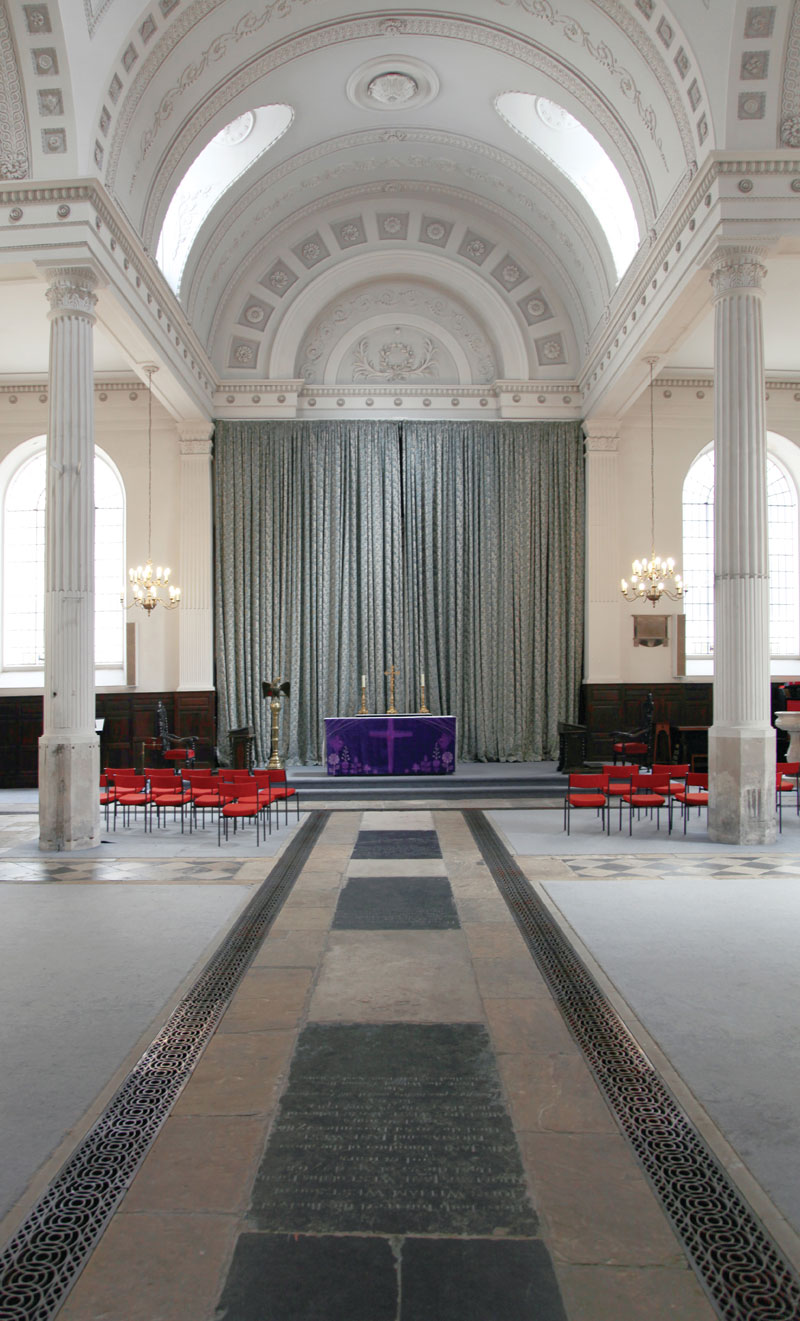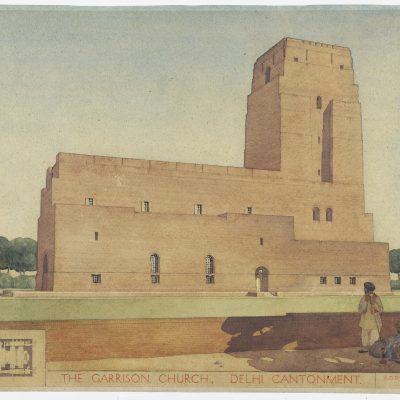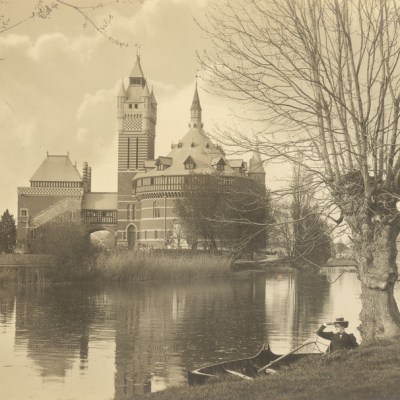Many of Wren’s city churches faced neglect and terrible destruction during the 19th and 20th centuries. But now there is little to excuse those parishes that are failing to preserve their historic interiors and fittings. From the May 2014 issue of Apollo.
‘I was desired to step into the little church behind the Mansion House, commonly called St Stephen’s, Walbrook’, recorded John Wesley in his diary for 1758. ‘It is nothing grand, but neat and elegant beyond expression, so that I do not wonder at the speech of the famous Italian architect who met Lord Burlington in Italy, “My lord, go back and see St Stephen’s in London. We have not so fine a piece of architecture in Rome”.’ It is a nice story, both because it suggests the quality of the churches designed by Sir Christopher Wren which were and are to be found in the City of London, and because it confirms the intellectual snobbery of Burlington, who sought perfection only in Italy, in Palladio, and had dismissed the work of Wren and his school.
The skyline Wren created for London after the Great Fire, with all his elaborate towers and steeples surrounding the great dome of St Paul’s, was often admired by foreigners, but fewer visitors seem to have sought out the interiors of those cleverly and variedly planned churches, with their carved reredoses, ornate pulpits and high box pews, as most were hidden away off the main thoroughfares in the City. Many found them dark, dowdy and neglected, especially after the advent of the railway depopulated the Square Mile. In The Uncommercial Traveller, Charles Dickens described how ‘these deserted churches…remain like the tombs of the old citizens who lie beneath them and around them, Monuments of another age.’
Then came the Union of Benefices Act of 1860, which allowed the sale of the sites of many of these churches, the money raised being used to build new ones in the suburbs. One by one they began to go: St Dionis, Backchurch; All-Hallows-the-Great; St Antholin, Budge Row…; the last of these – All Hallows Lombard Street – was demolished as late as 1938, despite the contemporary reverence for Wren. And then the Luftwaffe continued the policy of the Bishop of London, leaving many of the churches badly damaged or gutted. Some then disappeared altogether – St Mildred, Bread Street; St Swithin, London Stone – while others were restored: some accurately, but many in a deliberately different form internally (compared with, say, Warsaw or Leningrad, London’s post-war record of historic restoration is unimpressive).
After all these losses, the Wren City churches that survive largely intact and unaltered, such as St Mary Abchurch and St Margaret Lothbury, are all the more precious, and it might be thought that those that remain would be cherished. But not always. There is the strange case of the famous church Wesley and many others admired, St Stephen Walbrook, with its delicate dome raised above 16 columns within a rectangle to create a classical auditorium that is at once centralised and traditionally axial. Well restored after wartime damage, it has suffered from the questionable intervention of Peter Palumbo, who installed a round central altar made by Henry Moore – often compared to a ripe Camembert cheese – that wrecks the subtle tensions and ambiguities of the interior space. And now, notoriously, the Consistory Court of the Diocese of London has given the parish permission to sell the large painting of Devout Men Taking the Body of St Stephen (1776), which the artist, Benjamin West, intended as an altarpiece.
But worst of all is what has happened to the wonderful church of St Mary-at-Hill. Here, tucked away between Eastcheap and Billingsgate, Wren again played with the idea of a central dome over a Latin cross plan. After a fire in 1848, the church was altered by James Savage and new woodwork introduced – made by W. Gibbs Rogers in a totally convincing 17th-century style. The result was rightly praised by Elizabeth and Wayland Young in Old London Churches (1956): ‘…the real interest here lies in the woodwork…You come out of Billingsgate fish market into a landscape of dark, rich oak, where the work of those to whom the style was living and of those to whom it was dead blend in a paradoxical display of Restoration furniture at its very best.’
Anyone who saw this most beautiful and atmospheric little building loved it. Ian Nairn claimed it was ‘A Wren church as it should be, not genteel with light woodwork and scoutmaster-saints…[T]he fittings are everything. Old dark wood gleams in the light, a magnificent pulpit rears up into Wren’s domed space, magnificent iron sword-rests make curly patterns against the clear glass.’ But the most evocative description of St Mary-at-Hill as it was is that by John Betjeman, who in 1967 extolled ‘the least spoiled and the most gorgeous interior in the City…hidden away among cobbled alleys, paved passages, brick walls, overhung by plane trees and the smell of fish…The west end, with its glass and wood screen, gallery and magnificent organ case, the high pews with their many delicate sword-rests, the altarpiece, altar table, turned Communion rails, the sounding board and pulpit below, approached by a long wooden staircase with carved balusters, are all seen in a mysterious light filtering through pretty early Victorian windows…The atmosphere of merchant grandeur, pew-openers and the time of Dickens is unforgettable.’ As for the new woodwork, ‘it is so good that it is hard to make out which is 17th-century and which Gibbs Rogers’.
The interior of St Mary-at-Hill in its current state of partial restoration. Photo: Will Martin, 2014

On 10 May 1988 an accidental fire destroyed most of the roof of St Mary-at-Hill. Falling burnt timbers and plasterwork smashed many of the box pews. Further damage was caused by the water from the firemen’s hoses. At first it was proposed to make the church redundant, but a full restoration was soon promised and the roof, the plaster vaults and the dome were put back in 1990–91. But almost a quarter of a century on, the interior otherwise remains a bleak shell. The fine organ has been restored but the pews, pulpit, reredos and other pieces of furniture are all still missing even though the church has been in use again for two decades. For despite pressure from the Georgian Group and others, the church authorities do not seem disposed to honour the promise fully to restore the interior.
Money is not the problem – after all, there is quite a lot of it sloshing around in the City. The trouble is that the parish now likes to have a wide open floor which can be let for money-making secular activities such as ‘Wedding receptions, private receptions, formal or informal lunches…conferences, theatrical rehearsals and productions.’ But such things ought to take place in other City churches that are less interesting and precious, notably those which were inaccurately recreated after Second World War bombing. Nor can there be any excuse for having the recess where the reredos should be concealed by a ridiculous curtain or for the absent woodwork to be misleadingly dismissed as merely ‘Victorian’.
St Mary-at-Hill photographed on 12 May 1988, two days after a fire had destroyed most of the roof.

The once-glorious interior of St Mary-at-Hill not only should but can be recreated. The surviving woodwork is in store in Devon, and photographs I took of the church interior two days after the fire are evidence that most of it survived. There is no excuse for the dog-in-the-manger attitude of the parish: St Mary-at-Hill belongs to the nation, to all of us. If the Frauenkirche in Dresden can be immaculately restored after much worse wartime destruction, then what was once ‘the most gorgeous interior in the City’ deserves to be recreated.
From the May 2014 issue of Apollo. Click here to preview and subscribe.



